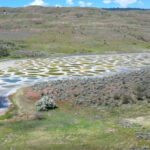Now Reading: Cloud Seeding: History, Scientific Principles, and Modern Applications
-
01
Cloud Seeding: History, Scientific Principles, and Modern Applications
Cloud Seeding: History, Scientific Principles, and Modern Applications

Cloud seeding is an innovative weather modification technique designed to enhance precipitation by introducing specific substances into clouds. From increasing rainfall in drought-stricken regions to mitigating the effects of natural disasters, cloud seeding has evolved into a vital tool for managing water resources and combating environmental challenges. This article explores the origins of cloud seeding, its underlying scientific principles, and its diverse modern applications.
History of Cloud Seeding
The idea of cloud seeding was first conceptualized in the mid-20th century. In 1946, Vincent Schaefer, working alongside Nobel laureate Irving Langmuir at General Electric, made the groundbreaking discovery that supercooled water droplets in clouds could be converted into ice crystals by introducing dry ice. This experiment marked the birth of artificial weather modification.
Shortly after, Bernard Vonnegut, Schaefer’s colleague, discovered that silver iodide, with a molecular structure similar to ice, could also induce ice nucleation. These early findings laid the foundation for cloud seeding as a practical technique.
Over the decades, numerous experiments were conducted to test the efficacy of cloud seeding. One notable project was Project Cirrus, a collaborative effort between the U.S. government, General Electric, and the military, which aimed to study cloud seeding’s potential in weather control. Despite facing challenges and skepticism, these early efforts spurred further research and development, cementing cloud seeding as a key area of atmospheric science.
Scientific Principles Behind Cloud Seeding
Cloud seeding operates on the principle of enhancing natural precipitation processes within clouds. To understand how it works, it is essential to grasp the role of cloud condensation nuclei (CCN) and ice nuclei in precipitation formation.
Cloud Condensation Nuclei (CCN): Clouds form when water vapor condenses around microscopic particles, such as dust or salt, to create water droplets. Without these nuclei, condensation would not occur efficiently.
Seeding Agents: Cloud seeding involves introducing artificial nuclei, such as silver iodide, dry ice (frozen carbon dioxide), or hygroscopic salts (e.g., sodium chloride), into clouds. These agents serve as additional surfaces for condensation or ice crystal formation.
Mechanisms of Seeding:
Cold-cloud seeding targets clouds containing supercooled water droplets. Silver iodide particles act as ice nuclei, prompting the droplets to freeze and grow into ice crystals. These crystals eventually fall as snow or melt into rain.
Warm-cloud seeding employs hygroscopic materials to encourage the growth of larger water droplets in warm clouds, leading to enhanced rainfall.
Detailed Process of Cloud Seeding:
Step 1: Identifying Target Clouds: Meteorologists identify clouds with potential for seeding, typically those with sufficient moisture but lacking effective nuclei to trigger precipitation.
Step 2: Selection of Seeding Agent: Depending on the type of cloud, either silver iodide (for cold clouds) or hygroscopic salts (for warm clouds) is selected. These materials are chosen for their ability to mimic natural nuclei.
Step 3: Delivery of Seeding Agent:
Aircraft Delivery: Planes equipped with flares or spraying systems release seeding agents directly into clouds at specific altitudes.
Ground-based Generators: Specialized machines release silver iodide particles into the atmosphere, which are then carried upward by air currents into the clouds.
Rocket Systems: Rockets are used in some programs to disperse seeding agents into hard-to-reach clouds.
Step 4: Nucleation Process: Once inside the cloud, the seeding agents act as nuclei, attracting water vapor or supercooled droplets. These accumulate around the nuclei, forming larger droplets or ice crystals.
Step 5: Precipitation Formation: As the droplets or crystals grow in size, they become heavy enough to fall as rain, snow, or sleet, depending on the atmospheric conditions.
Delivery Methods: Seeding agents are dispersed via aircraft, rockets, or ground-based generators, ensuring their optimal distribution within the target cloud.
Monitoring and Evaluation: Post-seeding, meteorologists use radar and other tools to monitor the cloud’s behavior, measure precipitation levels, and evaluate the effectiveness of the operation.
Modern Applications of Cloud Seeding
Cloud seeding has advanced significantly since its inception, finding applications across diverse sectors:
Agriculture and Drought Mitigation:
In arid and semi-arid regions, cloud seeding is employed to increase rainfall, alleviating water scarcity and supporting agriculture. For example, countries like India and the United Arab Emirates have invested heavily in cloud seeding programs to address chronic water shortages.
Water Resource Management:
Cloud seeding is used to augment water levels in reservoirs, rivers, and lakes, ensuring a stable supply for urban areas and industries. The western United States, including states like California and Colorado, relies on seeding to enhance snowfall in mountainous regions, subsequently increasing spring runoff.
Hail Suppression:
By introducing ice nuclei into storm clouds, cloud seeding reduces the size of hailstones, minimizing damage to crops, infrastructure, and property.
Fog Dissipation:
Airports and highways utilize cloud seeding to disperse fog, improving visibility and enhancing safety during adverse weather conditions.
Climate Control and Extreme Weather Mitigation:
Emerging research explores cloud seeding’s potential role in mitigating extreme weather events and combating the impacts of climate change, such as managing heatwaves or reducing the intensity of hurricanes.
Success Stories and Case Studies
Several successful cloud seeding initiatives underscore its potential:
China: In preparation for the 2008 Beijing Olympics, China conducted extensive cloud seeding to ensure clear skies during the event. The program reportedly achieved significant results, reducing rainfall during critical times.
United Arab Emirates: The UAE has invested millions in cloud seeding research and operations to combat water scarcity. Recent studies indicate that the program has contributed to measurable increases in rainfall.
Western United States: Programs aimed at enhancing snowpack in the Rocky Mountains have demonstrated notable success, with some regions reporting up to 15% additional precipitation.
Challenges and Controversies
Despite its promise, cloud seeding faces several challenges:
Environmental Concerns:
The long-term ecological impact of materials like silver iodide remains a subject of debate. While studies suggest minimal toxicity, further research is needed to confirm its safety.
Ethical and Geopolitical Issues:
The ability to modify weather raises ethical questions about fairness and unintended consequences. Cross-border weather modification can lead to conflicts, as neighboring regions may perceive it as resource monopolization.
Effectiveness and Predictability:
Cloud seeding does not guarantee precipitation. Its success depends on existing atmospheric conditions, and quantifying its effectiveness remains challenging.
The Future of Cloud Seeding
As technology advances, so does the potential for cloud seeding:
Emerging Technologies:
The use of drones and artificial intelligence is revolutionizing cloud seeding, enabling more precise and efficient operations.
Sustainable Materials:
Researchers are exploring eco-friendly alternatives to traditional seeding agents, minimizing environmental impact.
Combating Climate Change:
Cloud seeding may play a role in geoengineering strategies to address global warming, such as increasing reflectivity to reduce heat absorption.
Conclusion
Cloud seeding exemplifies humanity’s ingenuity in addressing environmental and climatic challenges. From its humble beginnings in the 1940s to its modern applications in agriculture, water management, and disaster mitigation, cloud seeding continues to evolve as a powerful tool. While challenges persist, ongoing research and technological innovation hold promise for a more sustainable and effective future. As we navigate a changing climate, cloud seeding serves as a reminder of our potential to adapt and innovate responsibly.


























